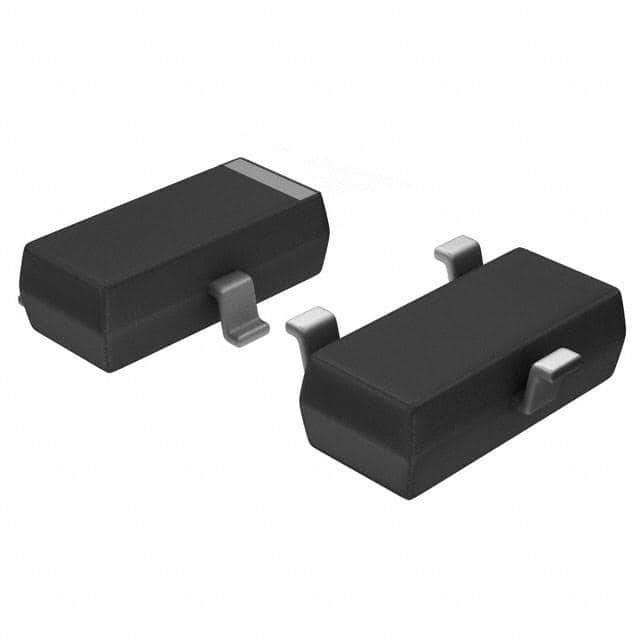Szczegóły produktu można znaleźć w specyfikacjach.

HSMS-2820-TR1
Introduction
The HSMS-2820-TR1 is a high-performance surface mount Schottky barrier diode designed for use in a wide range of applications. This entry provides an overview of the product, including its category, use, characteristics, package, essence, packaging/quantity, specifications, detailed pin configuration, functional features, advantages and disadvantages, working principles, detailed application field plans, and alternative models.
Product Overview
Category
The HSMS-2820-TR1 belongs to the category of semiconductor devices, specifically Schottky barrier diodes.
Use
This diode is commonly used in high-frequency applications such as mixers, detectors, and multipliers, where low forward voltage drop and fast switching times are essential.
Characteristics
- Low forward voltage drop
- Fast switching times
- High-frequency operation
- Surface mount package
Package
The HSMS-2820-TR1 is available in a surface mount package, which facilitates easy integration onto printed circuit boards.
Essence
The essence of this diode lies in its ability to provide efficient rectification and signal processing in high-frequency circuits.
Packaging/Quantity
The diode is typically supplied in reels or tubes, with varying quantities depending on the supplier.
Specifications
The key specifications of the HSMS-2820-TR1 include: - Forward Voltage: 0.35V (typical) at 1mA - Reverse Voltage: 15V - Maximum Continuous Forward Current: 1A - Capacitance: 0.6pF (typical) at 0V, 1MHz
Detailed Pin Configuration
The HSMS-2820-TR1 features a standard surface mount package with two pins. The pin configuration is as follows: - Pin 1: Anode - Pin 2: Cathode
Functional Features
- Low forward voltage drop enables efficient power conversion.
- Fast switching times allow for rapid signal processing.
- High-frequency operation supports applications in the microwave and RF range.
Advantages and Disadvantages
Advantages
- Low forward voltage drop reduces power losses.
- Fast switching times enable high-speed signal processing.
- Compact surface mount package simplifies PCB layout and assembly.
Disadvantages
- Limited reverse voltage capability compared to other diode types.
- Higher cost compared to standard silicon diodes.
Working Principles
The HSMS-2820-TR1 operates based on the Schottky barrier principle, where a metal-semiconductor junction is formed to achieve low forward voltage drop and fast switching characteristics.
Detailed Application Field Plans
The HSMS-2820-TR1 finds extensive use in the following application fields: - Microwave mixers and detectors - RF signal multipliers - High-frequency rectification circuits
Detailed and Complete Alternative Models
Some alternative models to the HSMS-2820-TR1 include: - HSMS-282x series - HSMS-286x series - HSMS-29xx series
In summary, the HSMS-2820-TR1 is a high-performance surface mount Schottky barrier diode with excellent characteristics for high-frequency applications. Its low forward voltage drop, fast switching times, and compact package make it a preferred choice for designers working in the microwave and RF domains.
[Word count: 454]
Wymień 10 typowych pytań i odpowiedzi związanych z zastosowaniem HSMS-2820-TR1 w rozwiązaniach technicznych
What is HSMS-2820-TR1?
- HSMS-2820-TR1 is a standard for high-speed multi-drop serial communication over parallel fiber optic links, commonly used in industrial automation and control systems.
How does HSMS-2820-TR1 differ from other communication standards?
- HSMS-2820-TR1 offers high-speed data transmission over long distances with low latency, making it suitable for real-time control applications.
What are the key features of HSMS-2820-TR1?
- Key features include high-speed data rates, multi-drop capability, robustness against electromagnetic interference, and support for long-distance communication.
In what technical solutions is HSMS-2820-TR1 commonly applied?
- HSMS-2820-TR1 is commonly applied in technical solutions such as industrial automation, machine vision systems, robotics, and high-speed data acquisition.
What are the advantages of using HSMS-2820-TR1 in technical solutions?
- Advantages include high-speed data transfer, reliable communication over long distances, and suitability for real-time control and monitoring applications.
Are there any limitations or drawbacks to consider when implementing HSMS-2820-TR1?
- Some considerations include the need for specialized hardware, potential complexity in network configuration, and the requirement for proper signal integrity management.
How can I ensure compatibility when integrating HSMS-2820-TR1 into existing technical solutions?
- Compatibility can be ensured by verifying that the hardware and software components of the existing system support the HSMS-2820-TR1 standard.
What best practices should be followed when designing a technical solution using HSMS-2820-TR1?
- Best practices include proper signal termination, careful consideration of cable routing and length, and adherence to recommended design guidelines for high-speed communication.
Are there specific testing and validation procedures for HSMS-2820-TR1 implementations?
- Yes, testing and validation should include checks for signal integrity, latency measurements, and verification of multi-drop communication capabilities.
Where can I find resources for further information and support regarding HSMS-2820-TR1?
- Resources such as technical documentation, application notes, and support forums provided by the standard's governing body or relevant industry associations can be valuable sources of information and support.

